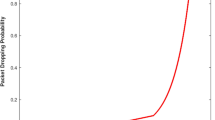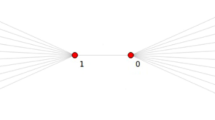Abstract
Random Early Detection (RED) is a recommended scheme of Active Queue Management (AQM) to avoid network congestion by Internet Engineering Task Force (IETF). RED being sensitive to its control parameters setting and traffic load behaves differently during different phases of scenarios and its performance degrades. To solve the above problems, we have proposed an improved algorithm LTRED, L stands for queue length and T stands for threshold, which incorporates the impact of load variation in early congestion notification along with tuning of threshold parameter of RED. Our approach is validated by doing extensive simulations on ns-2 (network simulator) and comparisons are done with RED, ARED, and AVQ well-known AQMs. Our approach has shown its superiority in terms of packet loss, early congestion indication, better link utilization, and improved goodput. In this work, mismatch between macroscopic and microscopic behavior of queue length of RED is also addressed and reduction in mismatch is achieved. In addition, LTRED makes very few changes to the original RED without making the system complex.
Access provided by CONRICYT-eBooks. Download conference paper PDF
Similar content being viewed by others
Keywords
- Random early detection (RED)
- Active Queue Management (AQM)
- IETF (Internet Engineering Task Force)
- ns-2 network simulator
1 Introduction
Due to the gigantic growth of the Internet, it faces the challenge of congestion [1, 2]. AQM is the solution to this congestion control. Its two main objectives are high link utilization with low packet loss and low packet queuing delay. Recommended by IETF [3] RED was first AQM, proposed by Sally Floyd and Jacobson in 1993 [4].
In RED algorithm, Exponential Weighted Moving Average (EWMA) filter as given by Eq. (1) is used for averaging of current queue size. For detection of actual congestion not transient one, averaging procedure is used. Here, two thresholds THmin minimum threshold and THmax maximum threshold are used and the average queue size is compared with these thresholds. If the average queue size is less than THmin no packet is dropped and if it is greater than THmax every incoming packet is dropped. When it lies between two thresholds, packets are randomly dropped using drop probability calculated by Eqs. (2) and (3).
where
- avgi+1:
-
average queue size at (i + 1)th time
- avg i :
-
average queue size at ith time
- w q :
-
moving weighted average constant
- q i :
-
current queue size
- THmin:
-
minimum threshold for queue
- THmax:
-
maximum threshold for queue
- P max :
-
maximum value for Pb
- P a :
-
current packet marking probability
- P b :
-
temporary probability used in calculation
- count:
-
packets since last discarded packet
Being simple in its approach, RED achieves goal of congestion avoidance, removes global synchronization, and overcomes drawback of Drop tail [3]. Despite having been widely used in combination with TCP for several years, RED has not found acceptance in the Internet research community [1]. It has some disadvantages like hard parameter setting, congestion depends on parameters, insensitivity toward input traffic and there is no matching between average queue length and current queue length [1]. After RED’s proposal, lot of research is carried out to find its suitability. Many variants of RED [2, 5,6,7,8,9] were proposed to overcome shortcomings of it with different congestion notification approaches used like the average queue size, packet loss and link utilization and control theory, etc.
The remainder of this paper is organized as follows. Section 2 gives the proposed work along with approach used, Sect. 3 gives simulation results and Sect. 4 deals with conclusions and the final section gives all the references used.
2 Proposed Work
Due to the exponential growth of the Internet, AQM fails to respond fast to traffic changes or to adapt to time-varying TCP dynamics. This motivated us for our proposed work. We have tuned the threshold parameter of RED that is threshold upper limit and lower limit of the average size in terms of router buffer size. Setting THmin to an appropriate value could help router to make good link utilization. Improper setting of THmax also causes more packets losses once the average queue size exceeds it. We have tuned THmin to 40% of maximum queue size and THmax to 70% of it. This tuning has given us good results as well as it helps to achieve the link utilization by properly keeping router buffer efficiently utilized. Since RED’s performance degrades heavily shown by wild oscillations when the traffic load becomes bursty indicating it is insensitive to input. We have incorporated this problem in our approach. A little amount work is already done in [10]. LTRED algorithm is shown in Fig. 1.
2.1 Working of Algorithm
For each packet arrival, average value for the queue size is calculated using EWMA as in original RED. To have impact of input traffic the current queue size is compared with a threshold which is 75% value of maximum buffer value (qt1) and depending upon that average value is updated by 5% of the current queue size. This step has impact of input sensitivity. Then it proceeds as RED algorithm. In order to find out if the congestion is sustained once again two checks are made. First, the current queue size is compared with another threshold (85% value of maximum buffer value—qt2) for bursty input and the average queue value is compared with a reference value which is mid value of upper and lower threshold value. If this comparison is found to be true, then packets are dropped earlier as compared to RED algorithm and this is early congestion indication to sources so that they should slow down their rate of sending packets. In rest part, it will continue to work as in original RED.
3 Simulation Results and Discussion
We have implemented the proposed scheme using network simulator ns-2 [11]. To evaluate the improvements network topology is shown in Fig. 2. Bandwidth and delay associated with links are also given in the diagram and Gs to Gr is bottleneck link. We have compared proposed scheme LTRED with RED [4], ARED [7] and AVQ [2], standard AQMs and plotted graphs for various cases.
Total simulation time period is 30 s for the topology shown Two FTP sessions randomly start in between 0 and 0.01 s and lasts till the end. In the middle of simulation, another “m” FTP session would randomly start in between 10.0 and 10.1 s which is to simulate changes of network conditions. TCP Reno is used for all AQMs (RED, ARED, AVQ and LTRED). Parameters used are, for RED and ARED are THmax = 15, THmin = 5, queue size q = 30, Maxp = 0.1, wq = 0.002, and for ARED and AVQ other parameters are set as per default value as in ns-2. In case of LTRED THmin = 12 and THmax = 21, qt1 = 22.5, qt2 = 25.5, and midth = 16.5 rest settings are similar to RED. We have observed results for sources varying “m” from 30 to 60 (Tables given) and drawn different graphs for 60 sources for all the approaches used. We have observed performance in case of packet loss, packet arrival ratio, the average queue size, and the current queue size.
Figure 3 shows the graph for comparison of packet loss for all the four cases showing minor differences during initial period of less traffic. After 10 s when traffic increases that is during congestion period LTRED shows less number of packet losses overall, and shows improvement by 2.3–4.3%. Figure 4 shows total number of packets received for all cases, it shows that packets delivered number is largest in case of LTRED, showing improvement in throughput by 2.19–3.48%. In Fig. 5, the graph shows effective congestion notification to sources in terms of packet arrival rate. Sources are earlier informed about congestion and they reduce their sending rate here also LTRED outperforms other AQMs.
Figure 6 depicts current queue changes, showing more variation in transient congestion and later on in highly congestion area, AVQ uses less buffer size Wild oscillations in RED and ARED show unstable behavior and in case of LTRED nearly stable behavior. Figure 7 illustrates bandwidth utilization which shows that LTRED outperforms other AQMs. Figure 8 shows average queue variation for RED, ARED, and LTRED, EWMA approach is used in these cases to calculate the average queue size. In this case also LTRED outperforms RED and ARED by being within its reference limit and depicts stable behavior. Figures 9, 10, and 11 show comparison of the average and the current queue size for RED, ARED, and LTRED cases. Out of these in LTRED case, mismatch behavior of the average and the current queue size is reduced a lot. Tables 1, 2, 3, and 4 give simulation results for number of sources varying from 30 to 60, showing superiority of LTRED.
4 Conclusion
In this work, we have proposed an AQM, LTRED which is sensitive to input traffic and also tuned threshold parameter in terms of buffer size, comparing it with RED, ARED and AVQ have demonstrated better performance in terms of less number of packet loss, effective congestion indication, high throughput, reduction in mismatch behavior of the average size and the current size and high goodput values due to which retransmission of packets also reduces a lot, and effective buffer utilization at router. An adaption mechanism based on input traffic is designed to drop the packet. The key concept is that as traffic load changes and queue length deviates from a threshold, dropping of packet occur.
References
Ryu S, Rump C, Qiao TC (2003) Advances in internet congestion control. IEEE Commun Surv Tutorials 5(1):28–39. https://doi.org/10.1109/COMST.2003.5342228
Kunniyur S, Srikant R (2004) An adaptive virtual queue [AVQ] algorithm for active queue management. IEEE/ACM Trans Networking 12(2):286–299
Braden B, Clark D et al. (1998) Recommendations on queue management and congestion avoidance in the Internet. IETF Request for Comments RFC 2309
Floyd S, Jacobson V (1993) Random early detection gateway for Congestion avoidance. IEEE/ACM Trans Netw 1(4):397–413
Sun J, Ko K, Chen G, Zukermam M (2003) PD-RED: to improve the performance of RED. IEEE Commun Lett 7(8):406–408
Athuraliya S, Li V et al. (2001) REM: active queue management. IEEE Netw 15(3):48–53. https://doi.org/10.1109/65.923940
Floyd S, Gummadi R, Shenkar S (2001) Adaptive RED: an algorithm for increasing the robustness of RED’s active queue management. Berkely CA [online]. http://www.icir.org/floyd/red.html
Li M, Zhao W (2010) Representation of a stochastic traffic bound. IEEE Trans Parallel Distrib Syst 21(9):1368–1372
Wang H, Ye Z, Wang B (2011) Using auto-tuning proportional integral probability to improve random early detection. IEEE 13th international conference on communication technology (ICCT)
Chhabra K, Kshirsagar M, Zadgaonkar A (2015) Effect of load and threshold variation on performance of RED: random early detection. Int J Sci Res 4(6):2319–7064. ISSN (online)
NS [network simulator] (1999) [online]. Available http://www.isi.edu/nsnam/ns
Author information
Authors and Affiliations
Corresponding author
Editor information
Editors and Affiliations
Rights and permissions
Copyright information
© 2018 Springer Nature Singapore Pte Ltd.
About this paper
Cite this paper
Chhabra, K., Kshirsagar, M., Zadgaonkar, A. (2018). An Improved RED Algorithm with Input Sensitivity. In: Bokhari, M., Agrawal, N., Saini, D. (eds) Cyber Security. Advances in Intelligent Systems and Computing, vol 729. Springer, Singapore. https://doi.org/10.1007/978-981-10-8536-9_5
Download citation
DOI: https://doi.org/10.1007/978-981-10-8536-9_5
Published:
Publisher Name: Springer, Singapore
Print ISBN: 978-981-10-8535-2
Online ISBN: 978-981-10-8536-9
eBook Packages: EngineeringEngineering (R0)















